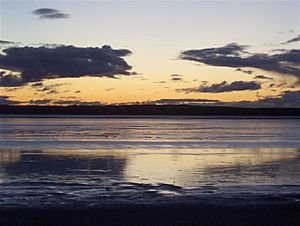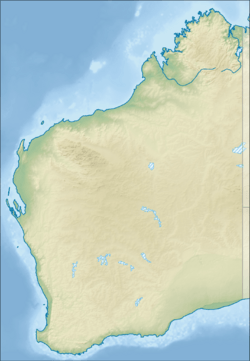Pink Lake (Western Australia) facts for kids
Quick facts for kids Pink Lake |
|
|---|---|

Pink Lake at sunset
|
|
| Location | Goldfields-Esperance, Western Australia |
| Coordinates | 33°50′43″S 121°49′40″E / 33.84528°S 121.82778°E |
| Type | Salt lake |
| Basin countries | Australia |
| Max. length | 4 km (2 mi) |
| Max. width | 2 km (1 mi) |
| Surface area | 990 ha (2,446 acres) |
| Surface elevation | 0 m (0 ft) |
Pink Lake is a salt lake in the Goldfields-Esperance region of Western Australia. It was once known as Lake Spencer.
This lake is famous because its water used to be a bright pink color. However, since about 2007, it has not been pink. The lake's color depends on how much salt is in its water. If the salt levels change, Pink Lake might become pink again.
Pink Lake is located about 3 kilometres (2 mi) west of Esperance. A road called the South Coast Highway runs along its eastern side. The lake lost its pink color because human activities changed its saltiness.
Why Pink Lakes Get Their Color
The amazing pink color in lakes like Pink Lake comes from tiny living things. These include a type of green algae called Dunaliella salina and a kind of bacteria called Halobacterium cutirubrum. Tiny brine prawns can also add to the color.
For the lake to turn pink, the water needs to be saltier than the ocean. It also needs to be warm and have enough sunlight. When these conditions are met, the algae start to make a red pigment called beta carotene. The pink bacteria also grow in the salt at the bottom of the lake.
It is thought that building the South Coast Highway and a railway line changed how water flowed into Pink Lake. This made the water less salty. That is why, as of 2017, the lake no longer looks pink.
The Lake's Name
In 1848, an explorer named John Septimus Roe called the lake Lake Spencer. He named it after Sir Richard Spencer, who helped set up the early colony of Western Australia. A nearby lake, Lake Warden, was named after Sir Richard Spencer's wife, Lady Ann Warden Spencer.
Over time, people started calling Lake Spencer "Pink Lake" because of its distinct pink color. In 1966, the name was officially changed to Pink Lake. For many years, it was a popular tourist spot in the Esperance area. Many local businesses and even a main road adopted the name "Pink Lake."
A Confusing Name
Today, tourists often visit Esperance hoping to see a pink lake, but they are disappointed. Because of this, some people have suggested changing the lake's name back to Lake Spencer. Others want to find a way to make the lake pink again.
Not to be Confused with Lake Hillier
There is another famous pink lake in Western Australia called Lake Hillier. This lake is on Middle Island, which is part of the Recherche Archipelago Nature Reserve. It is off the coast near Cape Arid National Park, east of Esperance.
Lake Hillier is well-known for its bright pink color, which looks amazing next to the deep blue ocean. The Western Australian Government manages Middle Island. You can visit Lake Hillier by boat or by air.
History of Pink Lake
Pink Lake used to be the final lake in the Lake Warden wetland system. Water from other lakes, like Wheatfield, Woody, and Windabout, would flow into Pink Lake. This brought salts into the lake.
When salt levels increased and water levels dropped in summer due to evaporation, the lake would turn pink. This is a natural process seen in many salt lakes. However, Pink Lake lost its connection to Lake Warden and the eastern lakes when the railway line and South Coast Highway were built.
Salt mining also affected the lake. Commercial salt mining started in 1896 and stopped in 2007. This mining reduced the salt levels in the lake. Also, more fresh water started flowing into the lake. This happened because of surface water and increased groundwater from nearby land clearing.
Salt Production
Before salt production began, the lake's environment was studied in the 1980s. Table salt is made in special ponds at the eastern end of the lake. A company called WA Salt Supply produces different types of salt there. These include salt for water softening, coarse salt, and sheepskin salt. The salt is dried, crushed, and bagged at the site before being sent out.
Birds of Pink Lake
Pink Lake is an important place for birds. BirdLife International has named it an Important Bird Area. This is because it often has many hooded plovers. Sometimes, it even has more than 1% of the world's population of banded stilts.
Many different types of birds, both native and those that migrate, have been seen at the lake. From 1997 to 2006, between 12 and 12,000 banded stilts were counted there. Between 1995 and 2005, the hooded plover population ranged from 5 to 68 birds.
Images for kids
See also
 In Spanish: Pink Lake (Australia Occidental) para niños
In Spanish: Pink Lake (Australia Occidental) para niños




